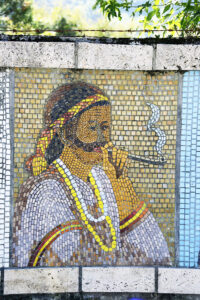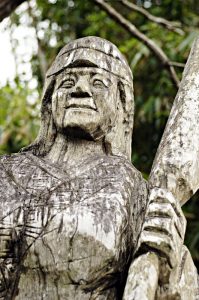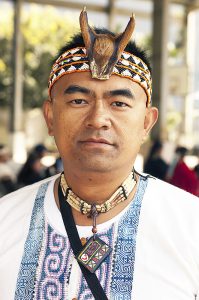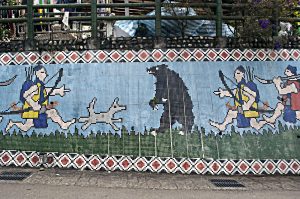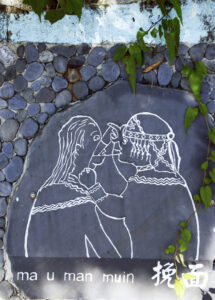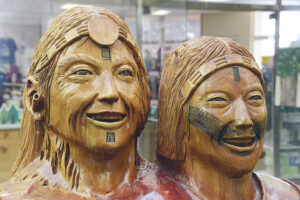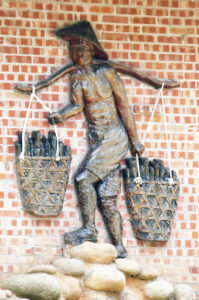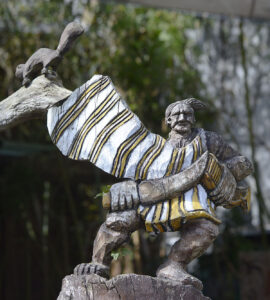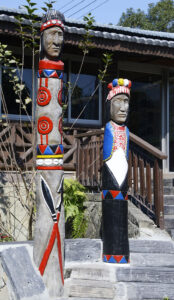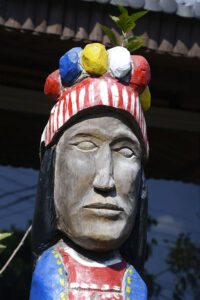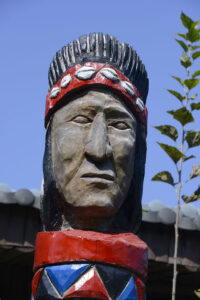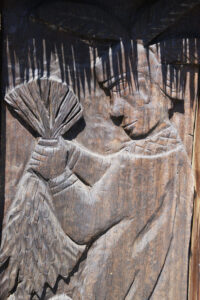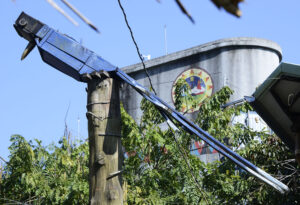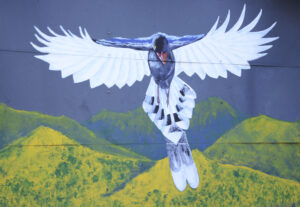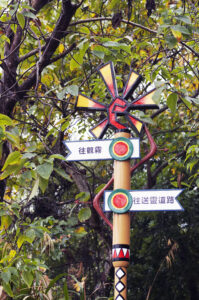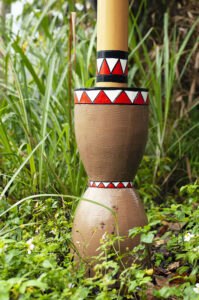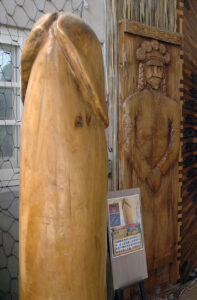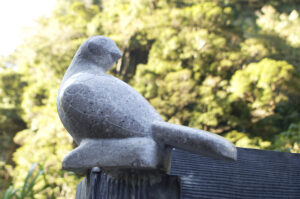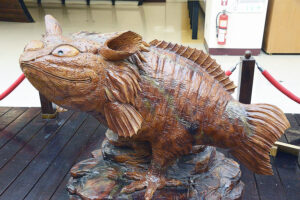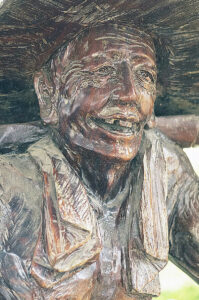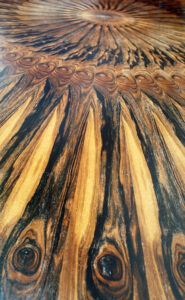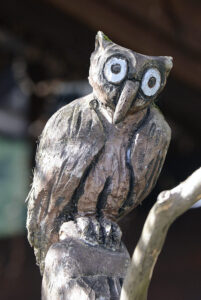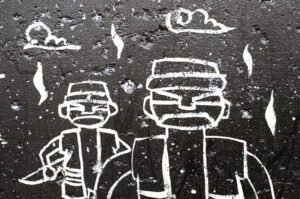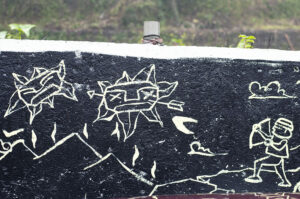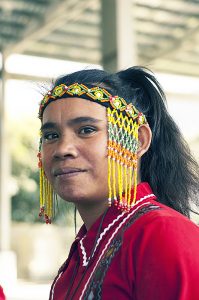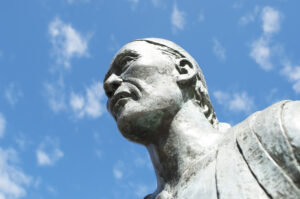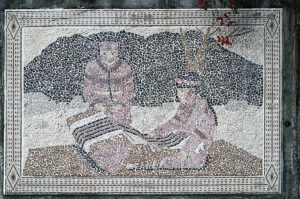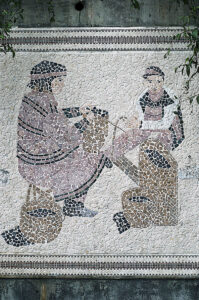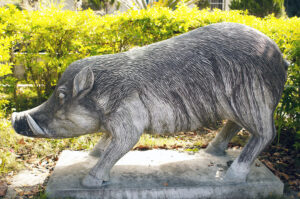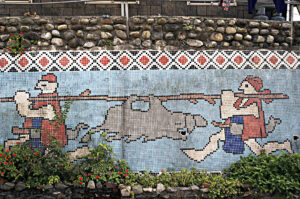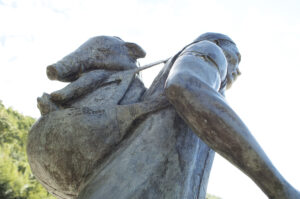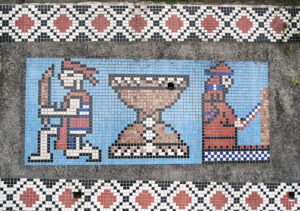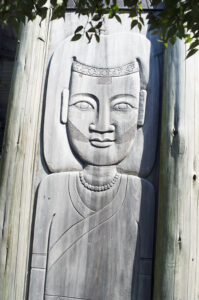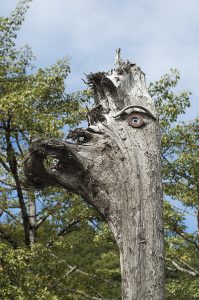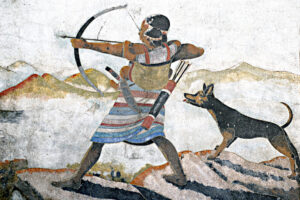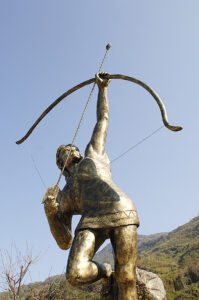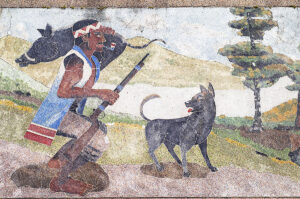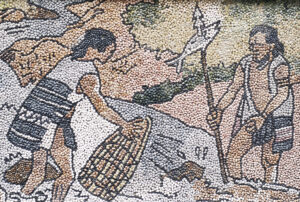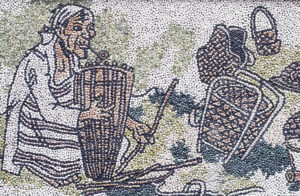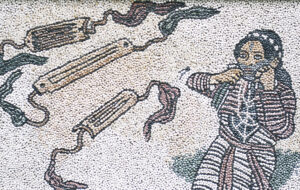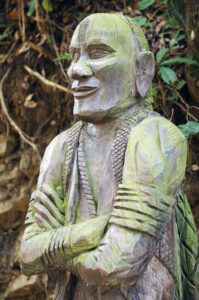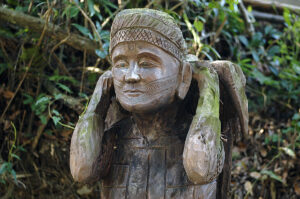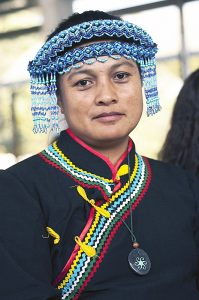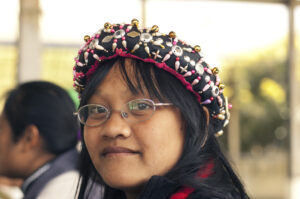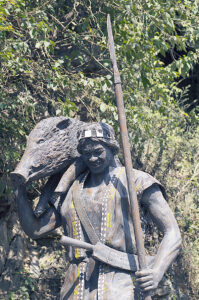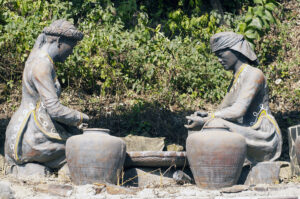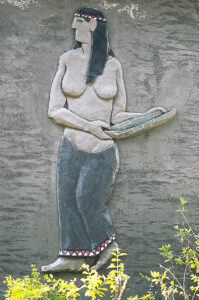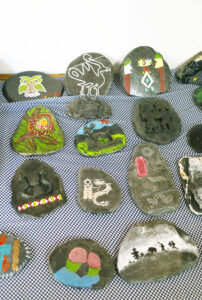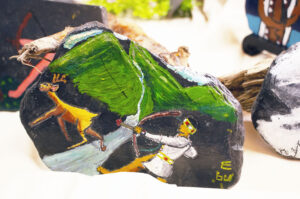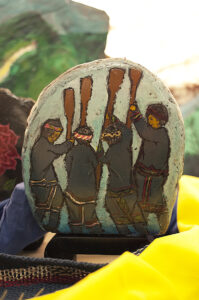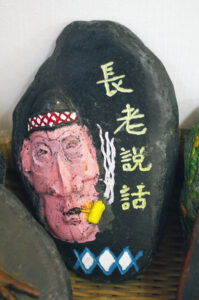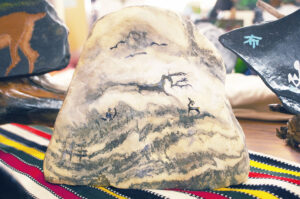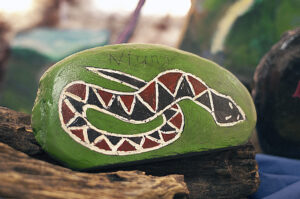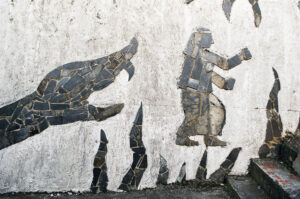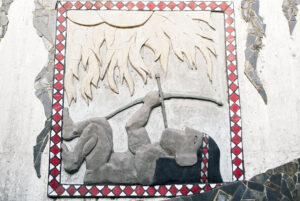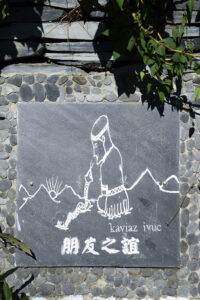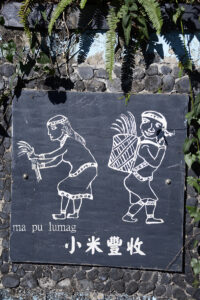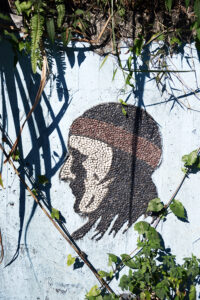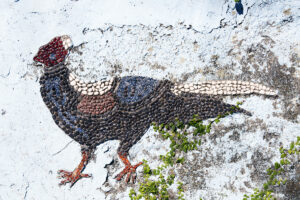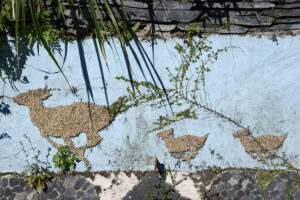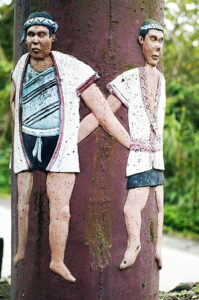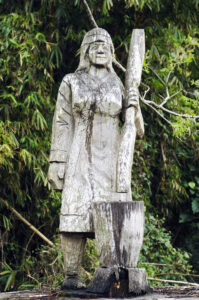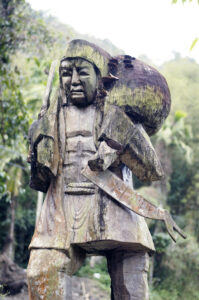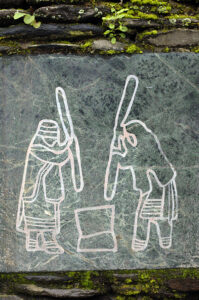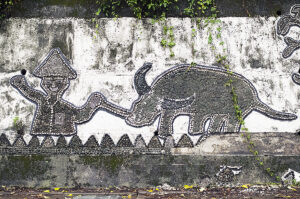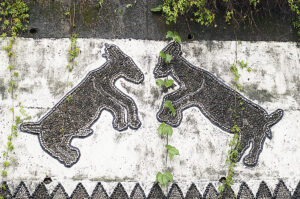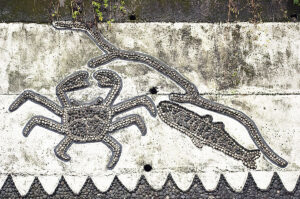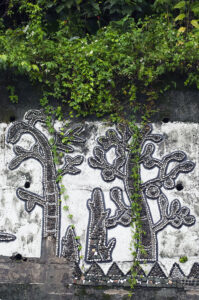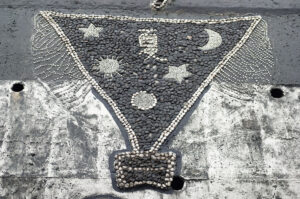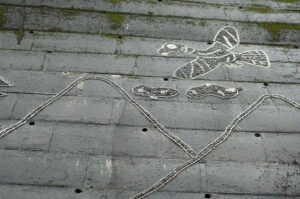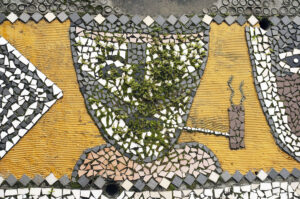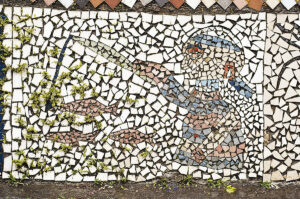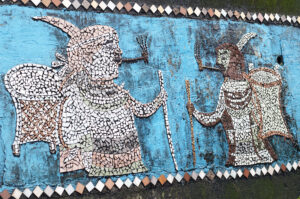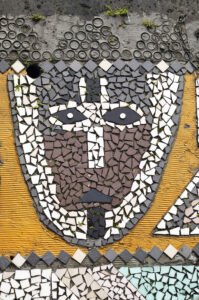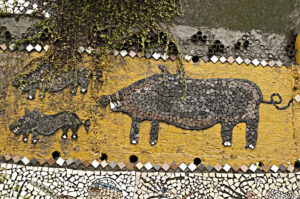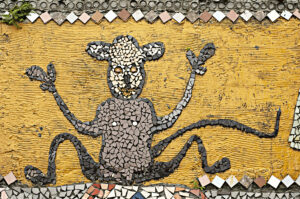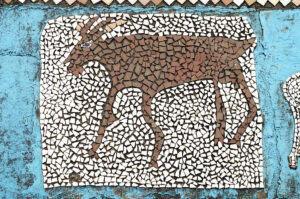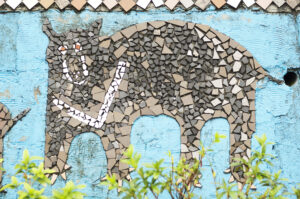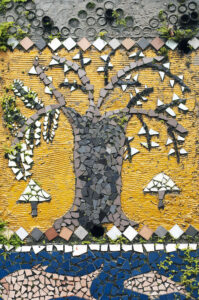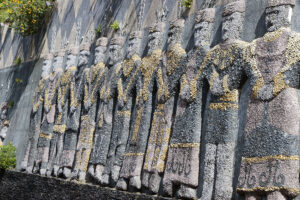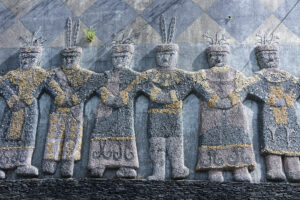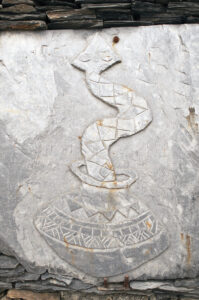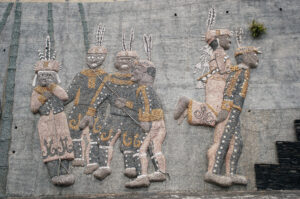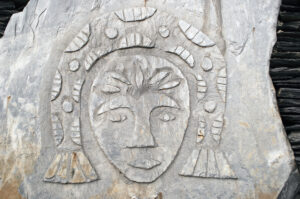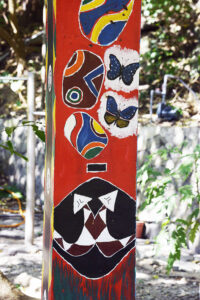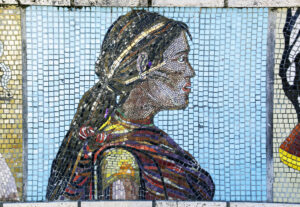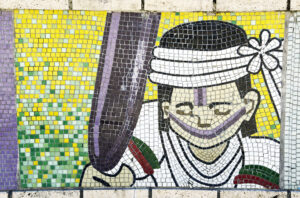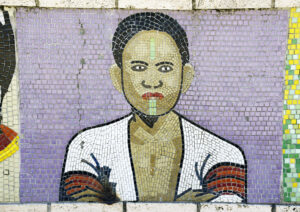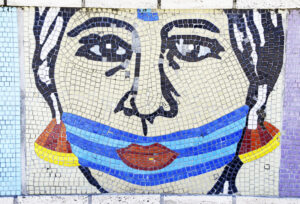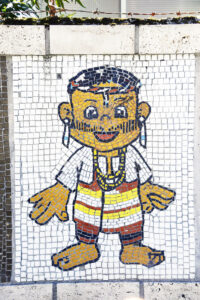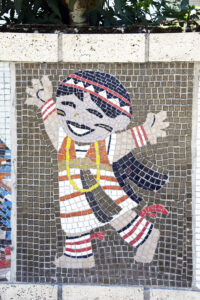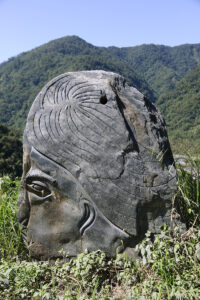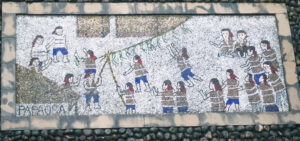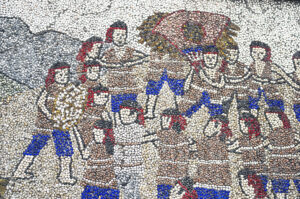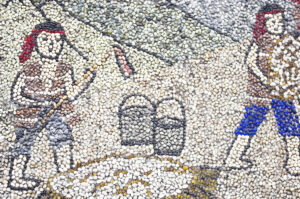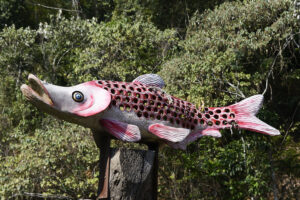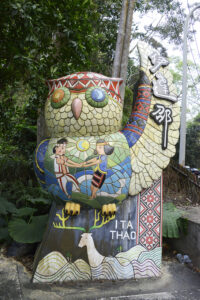Tribal art of Taiwan
This mosaic, observed at Wanda, near Wushe, central Taiwan, depicts a Sediq woman with tattooed face, smoking a pipe. (Photo copyright © by Kaj Halberg)
Detail of a wood carving from the neighbourhood of Taitung, depicting a Hsia-yeh woman with a pestle and mortar. (Photo copyright © by Kaj Halberg)
Bunun man in the village of Dilih, central Taiwan, wearing a woven headband, adorned with the horns of a Reeves’ muntjac (Muntiacus reevesi ssp. micrurus). In former days, aboriginals of Taiwan were keen hunters. (Photo copyright © by Kaj Halberg)
This mosaic, artwork of the Atayal tribe Da An (‘Great Peace’), who live in the mountains around Dongshih, near Taichung, depicts men and a dog, hunting an Asian black bear (Ursus thibetanus). This animal was formerly an important totem animal of several Taiwanese tribes. (Photo copyright © by Kaj Halberg)
The engraving on this slate slab from Wushe, central Taiwan, made by Bunun tribals, shows extraction of facial hair with a string. (Photo copyright © by Kaj Halberg)
Taiwan is home to a multitude of peoples of Malayan origin, who inhabited this island long before the invasion of Chinese peoples. Today, these tribes number about 600,000 persons, about 2.5% of the island’s population.
Officially, indigenous peoples of the island are divided into 16 groups, some of them with several sub-tribes: Amis, Atayal, Bunun, Hla’alua, Kanakanavu, Kavalan, Paiwan, Puyuma, Rukai, Saisiyat, Sakizaya, Sediq, Thao, Truku, Tsou, and Yami, each having its own distinct culture, language, customs, and social structure.
Some pictures, depicting ethnic minority groups of Taiwan, are shown on the pages People: Portraits, and People: Children around the world.
Many areas, especially in central Taiwan, are adorned with wonderful art, created by indigenous peoples.
Formerly, aboriginals of Taiwan were keen hunters, mainly hunting the wild boar (Sus scrofa), which was of huge importance as a food source, a fact, which is evident from their artwork.
The Asian black bear (Ursus thibetanus) played an important role as a totem animal. The sad fate of this animal is described on the page Folly of Man.
Another totem animal, venerated by various Taiwanese peoples, is the sharp-nosed pit viper (Deinagkistrodon acutus).
Below is first a number of pictures, depicting artwork of unidentified tribes, then artwork of various peoples.
This wood carving, exhibited in the visitor centre in Dasyueshan National Forest, depicts a tribal couple. Note their tattooed faces. (Photo copyright © by Kaj Halberg)
This relief depicts a tribal with two carrying baskets, full of charcoal, Sanyi. (Photo copyright © by Kaj Halberg)
These carvings, depicting a tribal warrior with a huge knife, and a squirrel, were exhibited at Buluowan, Taroko Gorge. (Photo copyright © by Kaj Halberg)
The following 6 pictures depict artwork, produced in a village near Cing Yun Waterfall, south of Alishan.
Carved totem poles, depicting an indigenous couple. (Photos copyright © by Kaj Halberg)
Door panel with a carving, depicting a man harvesting rice. (Photo copyright © by Kaj Halberg)
Wooden sculpture and a wall painting, both depicting Taiwan blue magpie (Urocissa caerulea). This species, which is endemic to Taiwan, is described on the page Animals – Birds: Birds of Taiwan. (Photos copyright © by Kaj Halberg)
Road sign, decorated with tribal art, Wufong, near Hsinchu. (Photos copyright © by Kaj Halberg)
In former times, large penises, carved in wood, were utilized among certain Taiwanese tribal peoples, when there had been a landslide. The women of the tribe would point the penis at the landslide, which, supposedly, would cause it to settle.
This large wooden penis was exhibited in the Lion’s Head National Scenic Area, northern Taiwan. (Photo copyright © by Kaj Halberg)
Stone sculpture, depicting a pigeon, Wushe (Renai). (Photo copyright © by Kaj Halberg)
This wood carving, exhibited in the visitor centre in Dasyueshan National Forest, depicts a mythical fish-like creature with bird’s feet and large external ears. (Photo copyright © by Kaj Halberg)
Tribal wood carving, Sanyi. (Photo copyright © by Kaj Halberg)
Table with a peacock-tail design, made from boards of wood with knots, Jiali Shan, Lion’s Head National Scenic Area, northern Taiwan. (Photo copyright © by Kaj Halberg)
For millennia, owls have appealed to people’s imagination due to their nocturnal living, silent flight, and mysterious hooting. They often play a role in indigenous mythologies, and carvings depicting owls are seen in many cultures around the world.
Owls play a role in the mythology of several Taiwanese indigenous peoples. This carving was exhibited at Buluowan, Taroko Gorge. (Photo copyright © by Kaj Halberg)
A widespread legend among the indigenous peoples of Taiwan relate that once upon a time there were two suns in the sky, making the climate unbearably hot. A mighty hunter took his bow and arrow and shot down one of the suns, which became the Moon.
These etchings were seen at Wufong, near Hsinchu. (Photos copyright © by Kaj Halberg)
Amis
This tribe, also known as Pangcah, are the most populous Taiwanese tribe, numbering about 180,000. They mainly live in the lowlands along the east coast, from Hualien southwards to Taitung. The Amis have a matrilineal society, where the husband moves in with the wife after marriage, and the children take the mother’s surname.
This woman of the Amis tribe, who wears a pearl ornament, paid a visit to a Bunun tribal fair in the village of Dilih, central Taiwan. (Photo copyright © by Kaj Halberg)
Atayal
This tribe call themselves Tayal, which simply means ‘people’. They mainly live in the northern mountains, numbering about 86,000 individuals, which makes them the third-largest indigenous group in Taiwan.
The artwork in the pictures below was created by members of the Atayal tribe Da An (‘Great Peace’), which lives in the mountains around Dongshih, northeast of Taichung.
Sculpture, depicting a Da An hunter. (Photo copyright © by Kaj Halberg)
These mosaics depict women, weaving clothes and baskets. (Photos copyright © by Kaj Halberg)
The wild boar (Sus scrofa) was formerly the most important food item of numerous indigenous tribes. (Photo copyright © by Kaj Halberg)
A mosaic and a sculpture, depicting hunters carrying killed wild boar home. (Photos copyright © by Kaj Halberg)
This mosaic shows a warrior with a sword, and a weaving woman. (Photo copyright © by Kaj Halberg)
Wood carving, depicting a woman with tatoos in her face. (Photo copyright © by Kaj Halberg)
This bird-like creature is made from an upside-down tree trunk. (Photo copyright © by Kaj Halberg)
This collection of artwork was made by members of the Atayal tribe Tian Gou (‘Heavenly Dog’), who also live near Dongshih.
Wall painting and sculpture, depicting the legend about the two suns and the hunter. (Photos copyright © by Kaj Halberg)
Mosaic, depicting hunters, killing a wild boar. (Photo copyright © by Kaj Halberg)
This wall painting depicts a hunter, who has bagged a wild boar. (Photo copyright © by Kaj Halberg)
In this mosaic, men catch fish, using a trap and a leister. (Photo copyright © by Kaj Halberg)
This mosaic shows an old woman with tattooed upper lip, who is smoking a pipe while weaving a carrying basket. (Photo copyright © by Kaj Halberg)
This one depicts a woman with tatooed face, and carrying straps. (Photo copyright © by Kaj Halberg)
Bei
These wooden sculptures, overgrown by algae, were produced by Bei tribals at Erbensung, Dasyueshan National Forest. They depict a warrior and a woman with tattooed face, who is carrying a basket, using a headband. (Photos copyright © by Kaj Halberg)
Bunun
The Bunun, numbering about 50,000 people, mainly live in the mountains in the central part of the island. They grow crops like millet, fruits, and vegetables, and supplement their diet with livestock and fishing.
The pictures below show various artwork of the Bunun tribe, exhibited at a tribal fair in the village of Dilih, central Taiwan.
Bunun women, wearing pearl ornaments. (Photos copyright © by Kaj Halberg)
Sculpture, depicting a hunter with a bagged wildboar. (Photo copyright © by Kaj Halberg)
This sculpture depicts women, cleaning rice. (Photo copyright © by Kaj Halberg)
This relief in a wall depicts a woman, sowing crops. (Photo copyright © by Kaj Halberg)
Stones, decorated with various subjects. (Photos copyright © by Kaj Halberg)
The painting on this stone shows a sharp-nosed pit viper, which is venerated as a totem animal by various Taiwanese tribes. (Photo copyright © by Kaj Halberg)
This relief shows a woman and a sharp-nosed pit viper. (Photo copyright © by Kaj Halberg)
This relief on a wall depicts the legend about the two suns and the hunter. (Photo copyright © by Kaj Halberg)
The pictures below show Bunun artwork, observed near the town of Wushe (Renai), central Taiwan.
Slate slab with an engraving, depicting a man and the tribe’s totem animal, the sharp-nosed pit viper. (Photo copyright © by Kaj Halberg)
This engraving on a slate slab shows women, harvesting millet. (Photo copyright © by Kaj Halberg)
Mosaic on a wall, depicting a tribal, wearing a headband. (Photo copyright © by Kaj Halberg)
This mosaic depicts a Swinhoe’s pheasant (Lophura swinhoii). Pictures of this endemic bird are shown on the page Animals – Birds: Birds of Taiwan. (Photo copyright © by Kaj Halberg)
Another mosaic, depicting a Taiwan serow (Capricornis swinhoei) with two kids. This animal, which is also endemic to Taiwan, was formerly hunted for food by various tribes, but is protected today. (Photo copyright © by Kaj Halberg)
Hsia-yeh
The artwork in the pictures below was produced by Hsia-yeh tribals, living near Taitung.
Carvings on a pole, depicting men. (Photo copyright © by Kaj Halberg)
Wooden sculpture, depicting a woman with pestle and mortar. (Photo copyright © by Kaj Halberg)
Wooden sculpture, depicting a hunter, carrying a bagged wild boar. (Photo copyright © by Kaj Halberg)
Engraving on a slate slab, depicting women with pestles and a mortar. (Photo copyright © by Kaj Halberg)
Lin
The mosaics below, observed at Wufong, near Hsinchu, was made by Lin tribals.
Happy farmer with his buffalo. (Photo copyright © by Kaj Halberg)
Fighting goats. Vines are growing up the mosaics. (Photo copyright © by Kaj Halberg)
Crab and fish. (Photo copyright © by Kaj Halberg)
Vines are growing up these mosaics, depicting trees. (Photo copyright © by Kaj Halberg)
Tribal flag. (Photo copyright © by Kaj Halberg)
Mountains and a giant bird. (Photo copyright © by Kaj Halberg)
Maopu
At Wufong, near Hsinchu, Maopu tribals created these mosaics from broken tiles.
Women, pounding rice in a mortar. (Photo copyright © by Kaj Halberg)
Pipe-smoking woman with tatooed face. Moss is growing on the image. (Photo copyright © by Kaj Halberg)
Fish and fishing woman. (Photos copyright © by Kaj Halberg)
Pipe-smoking women with carrying baskets. (Photo copyright © by Kaj Halberg)
Mask. (Photo copyright © by Kaj Halberg)
Wild boar sow with piglets. (Photo copyright © by Kaj Halberg)
The endemic Taiwan macaque (Macaca cyclopis) is common in most parts of the island. It is described on the page Animals – Mammals: Monkeys and apes. (Photo copyright © by Kaj Halberg)
Goat. (Photo copyright © by Kaj Halberg)
The Asian black bear was previously an important totem aninal for several tribes. (Photo copyright © by Kaj Halberg)
Crab. (Photo copyright © by Kaj Halberg)
Tree and fish. (Photo copyright © by Kaj Halberg)
Rukai
The Rukai people, numbering around 13,000 souls, live in mountains of southern Taiwan. They call themselves Drekai, and among the Taiwanese of Chinese descent they are known as Tsarisen (‘people living in the mountains’).
In former times, the Rukai revered the clouded leopard (Neofelis nebulosa), and also the sharp-nosed pit viper, which was regarded as the spirit of their ancestor.
The artwork in the pictures below, observed at Maolin, Kaohsiung County, is possibly made by Rukai people.
Wall relief, depicting dancing people. (Photos copyright © by Kaj Halberg)
This relief shows a sharp-nosed pit viper. (Photo copyright © by Kaj Halberg)
Relief, depicting playing tribals. (Photo copyright © by Kaj Halberg)
This relief depicts a mask. (Photo copyright © by Kaj Halberg)
Wooden pole in Maolin Butterfly Park, decorated with paintings of various subjects, including butterflies and two sharp-nosed pit vipers. (Photo copyright © by Kaj Halberg)
Sediq
The Sediq people, numbering around 10,000, live in mountains of central Taiwan.
The artwork below was created at Song Lin, near Wanda, Wushe (Renai).
Mosaic, depicting a pipe-smoking hunter. (Photo copyright © by Kaj Halberg)
These mosaics depict women with tattooed faces. (Photos copyright © by Kaj Halberg)
Mosaics, depicting happy children with tattooed faces. (Photos copyright © by Kaj Halberg)
Burial stone for a deceased man, carved out of a slate slab. (Photo copyright © by Kaj Halberg)
Taiping (Xi Sha)
The mosaics in the pictures below, made from pebbles, were created by Taiping tribals and exhibited at Wufong, near Hsinchu.
Children, playing volleyball. (Photo copyright © by Kaj Halberg)
Dancing tribals. (Photo copyright © by Kaj Halberg)
Tribals, catching fish. (Photo copyright © by Kaj Halberg)
Thao
The artwork in the pictures below was made by members of the Thao people, a small tribe who live around Sun Moon Lake.
As the Thao live around Sun Moon Lake, it is only natural that fish appear in their art. (Photo copyright © by Kaj Halberg)
This piece of tribal artwork depicts an owl, a dancing couple, and a deer. (Photo copyright © by Kaj Halberg)
(Uploaded February 2020)
(Latest update February 2025)
